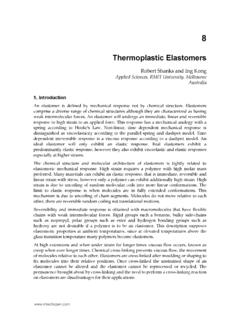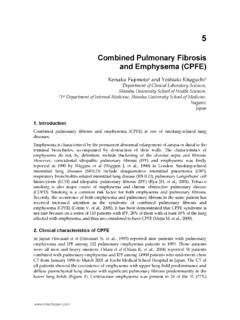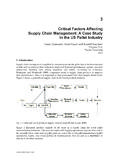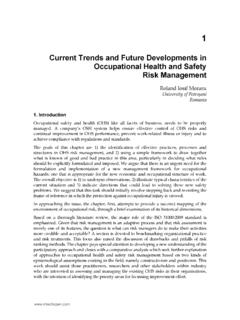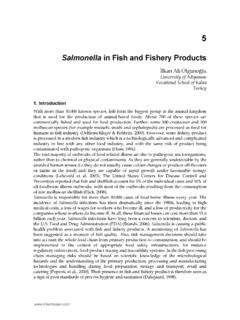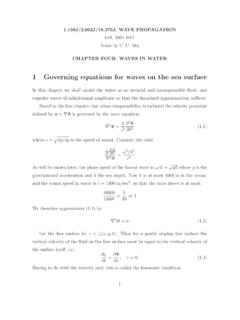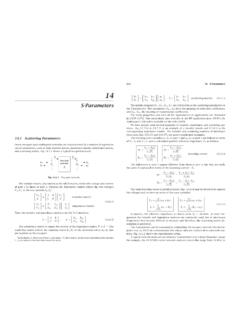Transcription of Electromagnetic Waves and Human Health - InTech
1 22. Electromagnetic Waves and Human Health Feyyaz zdemir1 and Ayseg l Kargi2. 1 The Black Sea University Medical Faculty, Medical Oncology Department Trabzon 2 Denizli Goverment Hospital, Medical Oncology Department Denizli, Turkey 1. Introduction Electromagnetic Waves are produced by the motion of electrically charged particles. These Waves are also called Electromagnetic radiation because they radiate from the electrically charged particles. They travel through empty space as well as through air and other substances. Electromagnetic Waves at low frequencies are referred to as Electromagnetic fields and those at very high frequencies are called Electromagnetic radiations (1,2). 2. Classification of Electromagnetic Waves According to their frequency and energy, Electromagnetic Waves can be classified as either ionizing radiations or non-ionizing radiations (NIR).
2 Ionizing radiations are extremely high frequency Electromagnetic Waves (X-rays and gamma rays), which have enough photon energy to produce ionization by breaking the atomic bonds that hold molecules in cells together. Non-ionizing (NIR) is a term for that part of the Electromagnetic spectrum which has photon energies too weak to break atomic bonds. They include ultraviolet radiation, infrared radiation, radiofrequency and microwave fields. NIR can not cause ionization however have been shown to produce other biological effects, for instance by heating, altering chemical reactions or inducing electrical currents in tissues and cells. There are four subgroups of Electromagnetic radiation fields with frequency and intensity. This Electromagnetic spectrum begins at a frequency of 1 Hertz ( Hz), which is 1 wave per second (1,2,3). Static electric Stationary electric charge that is built up on the surfaces and materials.
3 Electric fields are associated with the presence of electric charge, magnetic fields result from the physical movement of electric charge. Human body can not feel less than 2000 volts of static discharge. Magnetic fields can exert physical forces on electric charges when charges are in motion. The magnetic flux density measured in teslas (T), is accepted as the most relevant quantity for relating to magnetic field effects (4). A summary of sources of exposure to static fields in Table 2. 474 Electromagnetic Waves Type Frequency range Source Natural Video Static 0 Hz MRI. Industrial electrolysis Powerlines Extremely low frequency Domestic distribution (0< f 300 Hz), (ELF) Electric engines in cars, train and tramway Monitors, Anti theft devices in shops, Intermediate frequency (IF) 300 Hz < f 100 kHz Hands free access control systems, Card readers Metal detectors Broadcasting and TV.
4 Mobile telephony Microwave oven 100 kHz< f 300. Radio frequency (RF) Radar GHz Portable and stationary radio transceivers, Personal mobile radio. *Adopted from: Possible effects of Electromagnetic Fields (EMF) on Human Health . Scientific Committee On Emerging And Newly Identified Health Risks (SCENIHR) 19 July 2006 MRI: Magnetic Resonance Imaging Table 1. Classification and sources of Electromagnetic radiation fields*. Sources flux density Typical electric fields Video Display Unit, Tv 20 kV/m Under 500 Kv Transmission Line 30 kV/m Atmospher 12-150 V/m Typical magnetic fields Geomagnetic Field 0,03-0,07 mT. Magnetic Resonance Imaging (MRI) 2,5 T. Industrial DC Equipment 50 mT. Small Bar Magnets 1-10 mT. Magnetic Levitation Train 50 mT. Table 2. Sources of exposure to static fields and their flux densities. Electromagnetic Waves and Human Health 475.
5 Extremely Low Frequency (ELF). Extremely low frequency is a term used to describe radiation frequencies below 300 Hertz (Hz). ELF fields are oscillating fields and very important for public Health because of the widespread use of electrical power at 50-60 Hz in most countries (1,5). Intermediate Frequency (IF). Intermediate Frequency is a term to describe radiation frequency between 300 Hz and 100. kHz. There are experimental and epidemiological data from the IF range. Therefore, assessment of acute Health risks in the IF range is currently based on known hazards at lower frequencies and higher frequencies. Proper evaluation and assessment of possible Health effects from long term exposure to IF fields are important because Human exposure to such fields is increasing due to new and emerging technologies. Typical examples are: computer and tv screens with use cathode ray tubes, compact fluorescent lamps, as well as radio transmitters, anti theft devices in shops, hands free access control systems, card readers and metal detectors.
6 It is also used in electrosurgery (1,2). Radio Frequency (RF). RF is includes the frequencies between 100 kHz and 300 GHz of the Electromagnetic spectrum. RF sources is widespread used in whole world. Majority examples are mobile phones, broadcasting, medical and industrial applications. The RF sources are used in different frequency bands and subdivided in different categories: Sources operated close to the Human body Main examples of this type are mobile RF transmitters. One of the examples is mobile phones; more than billion people are using mobile phones worldwide. In addition to mobile phones, other wireless applications like cordless phones, DECT, or WLAN. systems are very common. The maximum peak power level of a DECT system is 250 mW, of a WLAN system 200 mW. Sources operated far away from the Human body Such sources are fixed installed RF transmitters.
7 An example is base stations that are an essential part of mobile communication networks. Medical applications Some medical applications use Electromagnetic fields in the RF range. Therapeutic applications such as soft tissue healing appliances, hyperthermia for cancer treatment, or diathermy expose the patient well above the recommended limit values to achieve the intended biological effects (1,5). 3. Effects on biological systems of electromagetic fields In 1935 Burr and Northrop examined and published the effects of stable voltage gradients on various biological systems. They were followed by a lot of scientists who found that stable voltage gradients led to many drastic changes in the organism, including growth and local injury. Studies have shown that these effects were associated with changes in distribution of ions (6). 476 Electromagnetic Waves According to some authors, there is connection with Electromagnetic fields and disappearance of bees known as colony collapse disorder in Europe and the US, and that it could also interfere with bird migration (7,8).
8 Fig. 1. The Electromagnetic Waves spectrum. Adopted from Electromagnetic cellular interactions Cifra M, Fields JZ, Farhadi A. 4. Effects of Human Health While the positive aspect of technologic innovation makes the life easier, it may also involve components that impair the quality of life via its certain negative effects. A discussion about the adverse effects of Electromagnetic Waves on the biological life has been ongoing since the discovery of electricity in the 19th century (6). Electromagnetic Waves generated by many natural and Human -made sources can travel for long distances and play a very important role in daily life. In particular, the Electromagnetic fields in the Radiofrequency (RF) zone are used in communications, radio and television broadcasting, cellular networks and indoor wireless systems. Resulting from the technological innovations, the use of Electromagnetic fields gradually increases and thus people are exposed to Electromagnetic Waves at levels much higher than those present in the nature (1,2,5).
9 Along with the widespread use of technological products in daily life, the biological effects of Electromagnetic Waves started to be discussed. Particularly, the dramatically increasing number of mobile phones users rise significant concerns due to its potential damage on people exposed by radiofrequency Waves . Since mobile phones are used in positions very close to the Human body and require a large number of base station antennas, the public and the scientists have question marks in their mind about the impact of mobile phone networks on Health (9). Evidence for cellular effects of Electromagnetic fields The general opinion is that there is no direct evidence of hazardous effects on Human Health incurred by low-frequency radiofrequency Waves . Studies at the cellular level, which uses Electromagnetic Waves and Human Health 477.
10 Relatively higher frequencies, demonstrate undesirable effects (10-11). Some studies revealed that different dimensions of Electromagnetic Waves have not shown any DNA damage on different cell lines. For example, in a comprehensive review published, Brusick et al have reported no evidence regarding the direct mutagenic effect of radiofrequency signals on cells (12). On the other hand, there are a lot of contrary study published in recent years. Most of them concerned about evidence of biochemical or cellular effects of Electromagnetic fields. Marino and Becker have shown that static or very low-frequency Electromagnetic fields may lead to biological effects associated with redistribution of ions. Furthermore, many studies demonstrated that biological effects of low-frequency magnetic fields may penetrate into deeper tissues (13).


